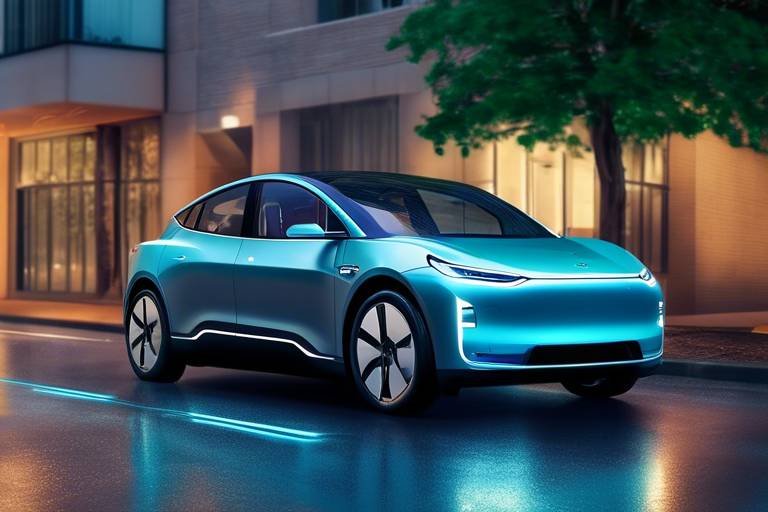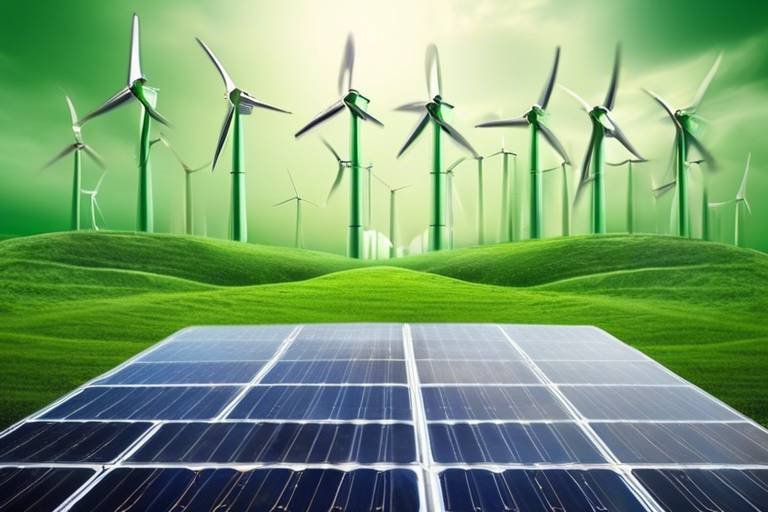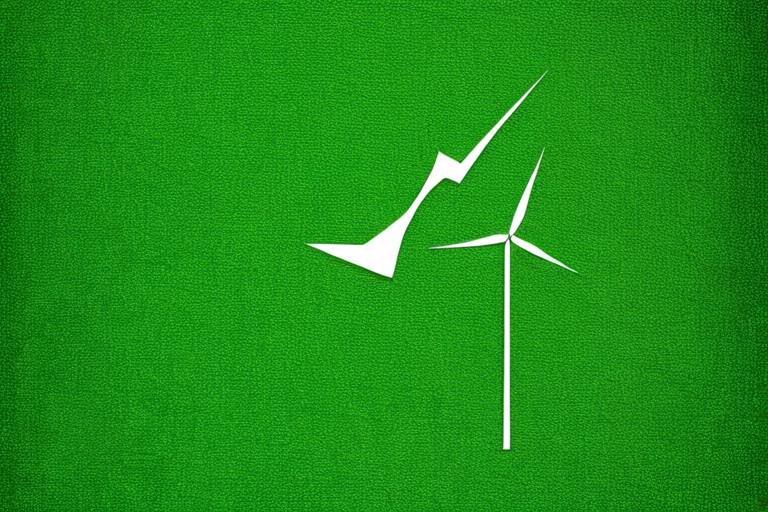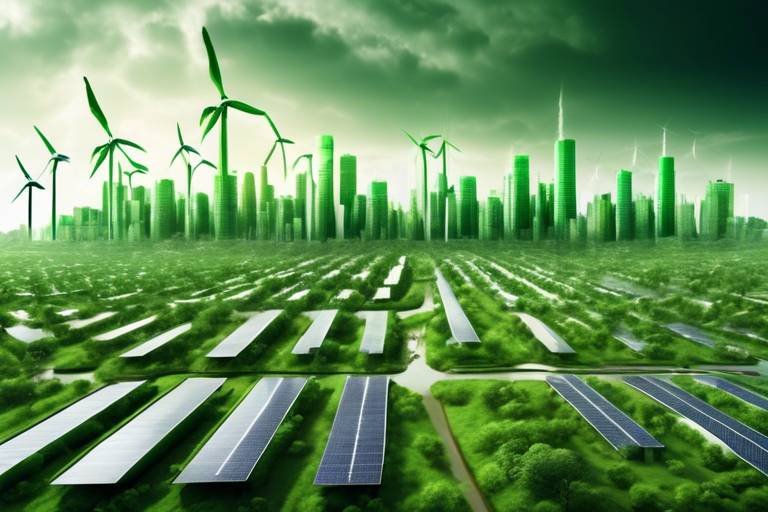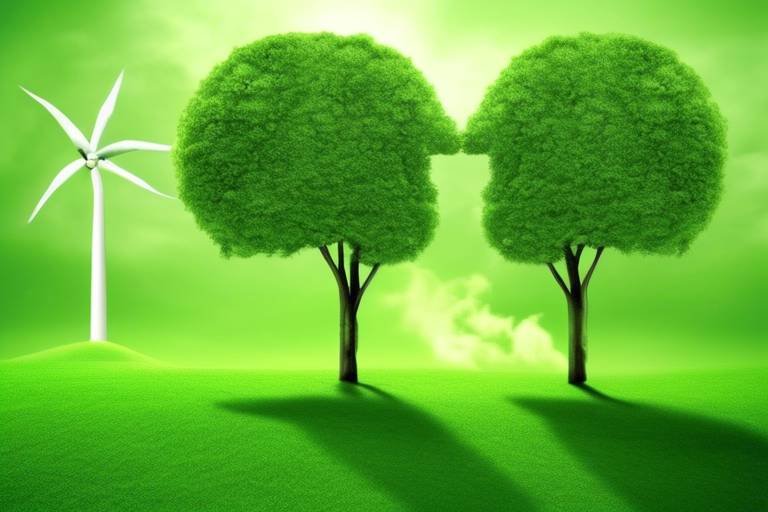Understanding the Basics of Hydroelectric Power
Hydroelectric power is one of the oldest and most reliable forms of renewable energy. It taps into the natural flow of water, converting its kinetic energy into electrical energy. Imagine a river flowing down a mountain; that movement can be transformed into electricity that powers our homes and industries. This remarkable process not only harnesses a natural resource but also plays a crucial role in reducing our reliance on fossil fuels, making it a vital player in the quest for sustainable energy solutions.
At its core, hydroelectric power relies on the simple principle of gravity. Water flows from higher elevations to lower ones, and when it does, it possesses kinetic energy. This energy can be captured using various technologies, primarily through dams and turbines. The water's movement spins the turbines, which are connected to generators that convert the mechanical energy into electrical energy. It’s like a giant waterwheel, but instead of grinding grain, it generates power for our daily lives. The beauty of this process lies in its efficiency and the minimal environmental impact when compared to traditional energy sources.
As we delve deeper into the world of hydroelectric power, it's essential to understand its historical context. The journey of hydroelectricity began in the late 19th century, marking a significant milestone in human innovation. The first hydroelectric power plant was built in 1882 in Appleton, Wisconsin, and since then, the technology has evolved tremendously. Today, hydroelectric power plants can be found all over the globe, contributing significantly to the energy mix of many countries.
However, like any other energy source, hydroelectric power has its challenges. Issues such as ecological impact, water rights, and the displacement of communities are critical considerations that need to be addressed. Despite these challenges, the advantages of hydroelectric power, including its ability to provide a steady and reliable energy supply, make it an attractive option for many regions. As we look to the future, advancements in technology and innovative approaches to energy generation will play a crucial role in enhancing the sustainability and efficiency of hydroelectric power.
- What is hydroelectric power? Hydroelectric power is energy generated by harnessing the energy of flowing water, typically through dams.
- How does a hydroelectric power plant work? It works by using flowing water to spin turbines connected to generators, converting kinetic energy into electrical energy.
- What are the benefits of hydroelectric power? Benefits include being a renewable energy source, reducing greenhouse gas emissions, and providing a reliable energy supply.
- What challenges does hydroelectric power face? Challenges include ecological impacts, water rights issues, and the need for significant infrastructure investment.

What is Hydroelectric Power?
Hydroelectric power is a fascinating and innovative way to generate electricity by harnessing the natural energy of flowing water. Imagine a river cascading down a mountain, its kinetic energy just waiting to be transformed into something useful. This is precisely what hydroelectric power does: it converts the power of moving water into electrical energy. By utilizing the gravitational force of falling or flowing water, hydroelectric plants can produce a significant amount of energy without the harmful emissions associated with fossil fuels.
The basic concept is straightforward. When water flows over a dam or through a turbine, it spins the turbine blades, which are connected to a generator. This generator then converts the mechanical energy of the spinning turbine into electrical energy. It's like a giant water wheel, turning the natural force of water into a powerful source of electricity that can light up homes, schools, and businesses.
One of the most remarkable aspects of hydroelectric power is its sustainability. Unlike fossil fuels, which can deplete and contribute to environmental degradation, hydroelectric power relies on the continuous cycle of water. As long as there are rivers and rainfall, we can harness this renewable resource. Moreover, hydroelectric power plants often have a lower carbon footprint compared to traditional energy sources, making them an essential component of our transition to a cleaner energy future.
To give you a clearer picture, let’s break down the process into key components:
- Water Source: This could be a river, lake, or reservoir.
- Turbines: These are the heart of the power generation process, converting water flow into mechanical energy.
- Generators: Connected to the turbines, they transform mechanical energy into electrical energy.
- Transmission Lines: These carry the generated electricity to homes and businesses.
In essence, hydroelectric power is not just about generating electricity; it’s about utilizing a natural resource in a way that benefits both people and the planet. As we continue to seek out sustainable energy solutions, understanding the fundamentals of hydroelectric power is crucial for appreciating its role in our energy landscape.

History of Hydroelectric Power
The history of hydroelectric power is as dynamic and flowing as the rivers that generate it. This form of energy harnessing dates back thousands of years, with the earliest uses stemming from ancient civilizations. The Greeks and Romans utilized water wheels for milling grain, a rudimentary but effective way of converting the kinetic energy of water into mechanical energy. Fast forward to the late 19th century, and the concept of hydroelectric power began to take on a more modern form. In 1882, the world's first hydroelectric power plant was built in Appleton, Wisconsin, marking a pivotal moment in energy production. This plant generated a mere 12.5 kilowatts of electricity, enough to power a few homes, but it laid the groundwork for future developments.
As the 20th century rolled in, hydroelectric power experienced a surge in popularity. The construction of large dams, such as the Hoover Dam in the United States during the 1930s, showcased the potential of hydroelectricity on a grand scale. This monumental structure not only provided power but also helped control flooding and provided water for irrigation. The success of such projects led to a boom in hydroelectric power plants across the globe. By mid-century, hydroelectric power was recognized as a primary energy source, contributing significantly to the electricity supply in many countries.
Throughout the decades, various nations have embraced hydroelectric power, leading to significant advancements in technology and infrastructure. For instance, in the 1950s and 1960s, the Soviet Union constructed the massive Sayano-Shushenskaya Dam, which became one of the largest hydroelectric power plants in the world. Its ability to generate over 6,400 megawatts of power showcased the sheer scale and efficiency that hydroelectric systems could achieve.
However, the history of hydroelectric power is not without its challenges. As environmental awareness grew in the late 20th century, concerns about the ecological impacts of large dams began to surface. This led to a reevaluation of hydroelectric projects, with a shift towards more sustainable practices. Today, the focus is on creating smaller, run-of-the-river hydroelectric systems that minimize ecological disruption while still harnessing the power of flowing water.
In summary, the journey of hydroelectric power from ancient water wheels to modern-day power plants reflects humanity's ongoing quest for sustainable energy solutions. As technology continues to evolve, the future of hydroelectric power remains bright, with innovations aimed at enhancing its efficiency and reducing its environmental footprint.
- What is the oldest hydroelectric power plant? The oldest hydroelectric power plant is the Appleton Dam in Wisconsin, built in 1882.
- How does hydroelectric power impact the environment? While hydroelectric power is renewable, large dams can disrupt local ecosystems and displace communities.
- What are the advantages of small hydroelectric systems? Small hydroelectric systems generally have a lower environmental impact and can be more easily integrated into existing landscapes.

How Hydroelectric Power Plants Work
Understanding how hydroelectric power plants operate is like peeling back the layers of an onion; beneath the surface lies a complex yet fascinating system that transforms the natural flow of water into usable energy. At the heart of this process is the conversion of kinetic energy from moving water into electrical energy, a feat that has been perfected over decades. So, how exactly does this transformation occur? Let's dive in!
Hydroelectric power plants typically consist of several key components that work together harmoniously. First and foremost, we have the dams, which are constructed across rivers to create a reservoir. This reservoir stores a significant amount of water, which can be released in a controlled manner to generate electricity. Imagine the dam as a giant water balloon; when you squeeze it, water rushes out, creating a force that can be harnessed for power.
Once the water is released from the reservoir, it flows through large pipes known as penstocks. These penstocks guide the water towards the turbines, which are the next critical component of the hydroelectric power plant. As the water rushes through the penstocks, it gains speed and kinetic energy, much like a roller coaster gaining momentum as it descends. This high-speed water then strikes the blades of the turbines, causing them to spin.
The spinning turbines are connected to generators, which are the heart of the electricity generation process. When the turbines rotate, they turn the rotor inside the generator, creating a magnetic field that induces an electric current. This process is based on the principles of electromagnetic induction, a concept that might sound complex, but in essence, it’s about converting mechanical energy (from the spinning turbines) into electrical energy. It’s like turning the energy from a spinning top into light by connecting it to a battery!
To summarize the process of energy generation in hydroelectric power plants, consider the following steps:
- Water Storage: Dams create reservoirs that store water.
- Water Release: Water is released through penstocks.
- Turbine Activation: Flowing water spins the turbines.
- Electricity Generation: Spinning turbines activate generators to produce electricity.
In addition to these components, hydroelectric plants also incorporate various control mechanisms to manage water flow and ensure optimal energy production. These include gates and valves that regulate the amount of water entering the penstocks, as well as systems to monitor the health and efficiency of the turbines and generators.
Moreover, the entire operation is designed with sustainability in mind. Hydroelectric power is often touted as a renewable energy source because it relies on the natural water cycle. Rainfall replenishes rivers and reservoirs, making it a clean alternative to fossil fuels. However, it’s essential to recognize that while hydroelectric power is renewable, it must be managed carefully to minimize its ecological impact.
In conclusion, hydroelectric power plants are marvels of engineering that efficiently convert the energy of flowing water into electricity through a series of well-coordinated processes. By harnessing the natural forces of our environment, these plants not only provide power but also contribute to a more sustainable energy future.
Q1: What are the main components of a hydroelectric power plant?
A: The main components include dams, penstocks, turbines, and generators.
Q2: How does a hydroelectric power plant generate electricity?
A: It generates electricity by converting the kinetic energy of flowing water into mechanical energy, which is then transformed into electrical energy by generators.
Q3: Is hydroelectric power renewable?
A: Yes, hydroelectric power is considered renewable because it relies on the natural water cycle.
Q4: What are some environmental concerns associated with hydroelectric power?
A: Some concerns include ecological impact on aquatic life, changes to water quality, and land use changes due to dam construction.

Components of a Hydroelectric Power Plant
When you think about a hydroelectric power plant, imagine a well-orchestrated symphony where each component plays a crucial part in creating a harmonious flow of energy. At the heart of this process are several key components that work together to convert the kinetic energy of flowing water into electrical energy. Let’s dive into the major players in this fascinating setup.
First up, we have the dam. This structure is not just a wall of concrete; it's the backbone of the hydroelectric system. By creating a reservoir, the dam stores a significant amount of water, which can be released at controlled rates to generate power. Think of it as a giant battery, holding potential energy that can be unleashed when needed. The height of the water in the reservoir creates pressure, which is essential for the next component: the turbine.
The turbine is often dubbed the "heart" of the hydroelectric plant. As water flows through the dam and into the turbine, it spins the blades, converting the kinetic energy of the moving water into mechanical energy. This is similar to how wind turns the blades of a windmill. The efficiency of the turbine is crucial; a well-designed turbine can significantly increase the amount of electricity generated.
Next, we have the generator. Once the turbine is spinning, it’s time for the magic to happen. The generator takes the mechanical energy produced by the turbine and converts it into electrical energy. Inside the generator, magnets and coils of wire work together to create electricity through electromagnetic induction. It’s a bit like how a bicycle dynamo works, turning the motion of the bike into light for your path ahead.
Another vital component is the penstock, which is essentially a large pipe that carries water from the reservoir to the turbine. This pipe is designed to withstand high pressure, ensuring that the water can flow smoothly and efficiently. Imagine it as a water slide; the steeper and smoother the slide, the faster you go!
Finally, we have the control systems. These systems monitor and manage the entire operation of the hydroelectric plant. They ensure that everything is running smoothly, from the flow of water to the output of electricity. Advanced control systems use sensors and automation to optimize performance and maintain safety standards. Think of them as the conductors of our symphony, ensuring that all parts are in sync and functioning harmoniously.
In summary, the components of a hydroelectric power plant work together like a finely tuned machine. Each part is essential to the overall process, from the dam that holds the water, to the turbine that spins, the generator that produces electricity, the penstock that channels the water, and the control systems that keep everything in check. Understanding these components gives us a deeper appreciation of how hydroelectric power harnesses nature's energy to provide us with clean, renewable electricity.
- What is the main purpose of a dam in a hydroelectric power plant? The dam stores water and creates a reservoir, which helps in controlling the flow of water to generate electricity efficiently.
- How does a turbine work in hydroelectric power generation? The turbine spins when water flows through it, converting kinetic energy into mechanical energy, which is then transformed into electrical energy by the generator.
- What role do control systems play in a hydroelectric power plant? Control systems monitor and manage the operation of the plant, ensuring optimal performance and safety throughout the energy generation process.

Process of Energy Generation
The process of generating energy from hydroelectric power is a fascinating interplay of nature and technology. Imagine a river flowing down a mountainside, its water rushing with kinetic energy, just waiting to be harnessed. This is where the magic begins! The first step involves the construction of a dam, which creates a reservoir. This reservoir stores a significant amount of water, allowing for controlled flow. When electricity is needed, water is released from the reservoir through a series of gates.
As the water flows down, it gains speed and kinetic energy. This is where the heart of the hydroelectric power plant comes into play: the turbine. The rushing water strikes the blades of the turbine, causing it to spin. It’s a bit like a pinwheel catching the wind—only in this case, the wind is a powerful stream of water! The turbine is connected to a generator, which is the next key component in this energy transformation process.
As the turbine spins, it turns the rotor inside the generator. This action converts the mechanical energy from the turbine into electrical energy through electromagnetic induction. It’s a remarkable process that’s been fine-tuned over the years. The generated electricity is then sent through transformers, which increase the voltage for efficient transmission over power lines. This entire process is not just efficient but also remarkably sustainable, as it relies on the natural water cycle.
To give you a clearer picture, here’s a simple breakdown of the energy generation process:
- Water Storage: The dam creates a reservoir that stores water.
- Controlled Release: Water is released from the reservoir through gates.
- Turbine Activation: Flowing water strikes the turbine blades, causing them to spin.
- Energy Conversion: The turbine’s movement turns the generator, producing electricity.
- Transmission: Electricity is transformed and sent out through power lines.
This entire cycle is a perfect example of how we can harness natural resources to generate energy sustainably. By using flowing water, hydroelectric power plants can produce large amounts of electricity without the harmful emissions associated with fossil fuels. However, it’s important to remember that while this process is efficient, it is not without its challenges, which we will explore further in upcoming sections.
Q: How much electricity can a hydroelectric power plant generate?
A: The amount of electricity generated varies based on the size of the plant, the flow rate of the water, and the height from which the water falls. Large plants can generate several thousand megawatts, enough to power millions of homes.
Q: What happens during a drought?
A: During drought conditions, water levels in reservoirs can drop significantly, affecting the plant’s ability to generate power. Some plants have backup systems or can use alternative energy sources during these times.
Q: Are there any environmental impacts of hydroelectric power?
A: Yes, while hydroelectric power is cleaner than fossil fuels, it can impact local ecosystems. Dams can disrupt fish migration and alter water temperatures and flow patterns, affecting aquatic life.
Q: How does hydroelectric power compare to solar and wind energy?
A: Hydroelectric power is more consistent than solar and wind energy because it can generate electricity continuously as long as there is water flow. However, solar and wind energy are also renewable and play a crucial role in a diversified energy portfolio.

Advantages of Hydroelectric Power
Hydroelectric power is often hailed as one of the most efficient and sustainable sources of energy available today. But what exactly makes it stand out from other energy sources? Let’s dive into some of the key advantages that hydroelectric power brings to the table.
First and foremost, hydroelectric power is a renewable energy source. Unlike fossil fuels, which can deplete over time, hydroelectric power relies on the natural water cycle. Rainfall replenishes rivers and lakes, ensuring a continuous supply of water. This means that as long as we have flowing water, we can generate electricity, making it a sustainable choice for the long haul.
Another significant advantage is the reduction of greenhouse gas emissions. When we compare hydroelectric power to traditional fossil fuel plants, the difference is striking. Hydroelectric facilities produce minimal emissions, contributing to cleaner air and a healthier environment. In fact, according to the International Hydropower Association, hydroelectric power can reduce carbon dioxide emissions by up to 90% compared to coal-fired power plants.
Moreover, hydroelectric power plants often have a long operational lifespan. Many of these facilities have been in operation for decades, and with proper maintenance, they can continue to function efficiently for many more. This longevity translates to lower costs over time, making hydroelectric power a financially savvy choice for energy production.
Additionally, hydroelectric power plants can provide a dual benefit: they can also serve as flood control mechanisms. By managing water flow, these facilities can help mitigate the risks associated with heavy rainfall and flooding. This aspect not only protects local communities but also ensures a more stable environment for agriculture and wildlife.
Let’s not forget about the economic benefits. Hydroelectric power plants can create jobs in construction, maintenance, and operation. Furthermore, they can stimulate local economies by providing affordable electricity to residents and businesses. This leads to lower energy bills and can attract new industries to the area, fostering growth and development.
In summary, the advantages of hydroelectric power are numerous and impactful. From being a renewable energy source to reducing greenhouse gas emissions and providing economic benefits, hydroelectric power is a crucial player in our quest for sustainable energy solutions. As we continue to face the challenges of climate change, embracing hydroelectric power could be a significant step towards a greener future.
- What is the main advantage of hydroelectric power? The primary advantage is its sustainability and minimal environmental impact compared to fossil fuels.
- How does hydroelectric power help the economy? It creates jobs, reduces energy costs, and can stimulate local economic growth.
- Are there any environmental concerns with hydroelectric power? Yes, while it has many benefits, it can also impact aquatic ecosystems and local wildlife.
- Is hydroelectric power truly renewable? Yes, as long as there is a water cycle, hydroelectric power can be considered renewable.

Challenges and Limitations
While hydroelectric power presents a multitude of benefits, it is not without its . One of the most significant concerns is the potential ecological impact on local ecosystems. When a dam is constructed, it can disrupt the natural flow of rivers, affecting fish migration patterns and altering habitats for various wildlife. This disruption can lead to a decline in fish populations, which can have cascading effects on the entire ecosystem. Isn't it fascinating how something as powerful as water can also be a double-edged sword?
Another challenge that often arises is related to water rights. In many regions, water is a precious resource that is shared among various stakeholders, including farmers, municipalities, and industries. Disputes can arise over who has the right to use the water, especially in areas experiencing drought or low water levels. Such conflicts can delay or even halt the development of new hydroelectric projects, leading to missed opportunities for clean energy generation.
Moreover, hydroelectric power plants face limitations in terms of geographical location. Not every region has the necessary topography or water flow to support a hydroelectric facility. This geographical limitation can result in a concentration of hydroelectric plants in certain areas, leading to potential over-reliance on this energy source and limiting its availability in others. In essence, it’s like trying to fit a square peg into a round hole; not every location is suitable for hydroelectric power generation.
Furthermore, the construction and maintenance of dams and hydroelectric facilities can be costly and time-consuming. While the initial investment can yield long-term benefits, the upfront costs can deter investors and developers. Additionally, the aging infrastructure of existing plants poses another challenge. Many facilities built decades ago require significant upgrades to meet modern safety and environmental standards, which can further strain financial resources.
Lastly, climate change poses a significant challenge to hydroelectric power generation. Changes in precipitation patterns can lead to inconsistent water flow, affecting the ability of hydroelectric plants to generate electricity reliably. For instance, regions that experience severe droughts may find their hydroelectric output significantly reduced, leading to energy shortages. It's a stark reminder that while we harness nature's power, we are also at the mercy of its whims.
In summary, while hydroelectric power is a vital component of the renewable energy landscape, it comes with its own set of challenges and limitations. Addressing these issues requires careful planning, collaboration among stakeholders, and innovative solutions to ensure that hydroelectric power can continue to contribute to a sustainable energy future.
- What are the main environmental concerns associated with hydroelectric power?
The main concerns include disruption of aquatic ecosystems, fish migration patterns, and potential impacts on local wildlife. - How do water rights affect hydroelectric power projects?
Water rights can lead to disputes among different stakeholders, potentially delaying or halting hydroelectric project developments. - Can hydroelectric power generation be affected by climate change?
Yes, changes in precipitation patterns can lead to inconsistent water flow, impacting the reliability of hydroelectric power generation.

Future of Hydroelectric Power
The future of hydroelectric power is not just bright; it's positively electrifying! As we stand at the crossroads of energy innovation and environmental necessity, hydroelectric power is poised to play a pivotal role in our transition to sustainable energy solutions. With advancements in technology and a growing awareness of ecological impacts, the hydroelectric sector is evolving to meet the demands of a changing world.
One of the most exciting trends is the integration of smart grid technology with hydroelectric systems. This technology allows for real-time monitoring and management of electricity flow, optimizing energy distribution and enhancing efficiency. Imagine a future where hydroelectric plants can respond instantly to changes in energy demand, much like a conductor guiding an orchestra. This adaptability not only maximizes output but also minimizes waste, making hydroelectric power even more appealing.
Moreover, innovations in turbine design are revolutionizing the way we harness water energy. Traditional turbines can be quite large and require significant water flow to operate efficiently. However, new designs, such as small-scale and micro-hydroelectric systems, are emerging. These systems can generate power from smaller water sources, such as streams and rivers, which were previously considered too insignificant for energy production. This opens up a world of possibilities, especially in rural and remote areas where access to energy is limited.
Furthermore, the focus on environmental sustainability is driving research into fish-friendly turbine designs. These innovations aim to minimize the impact on aquatic life, ensuring that hydroelectric power generation does not come at the expense of local ecosystems. By creating turbines that allow fish to pass safely, we can strike a balance between energy production and ecological preservation.
Policy changes and government incentives are also shaping the future of hydroelectric power. Many countries are recognizing the importance of renewable energy sources and are implementing supportive measures to encourage investment in hydroelectric projects. This not only boosts the economy but also aligns with global efforts to reduce carbon emissions and combat climate change. The synergy between policy and technology will be crucial in propelling hydroelectric power into the forefront of renewable energy.
In addition to these advancements, the concept of pumped storage hydroelectricity is gaining traction. This method stores energy by pumping water uphill during low-demand periods and releasing it to generate electricity during peak demand. It's like having a battery that uses water instead of chemicals, providing a reliable way to balance supply and demand. As energy storage becomes increasingly important in our grid systems, pumped storage could be a game-changer for hydroelectric power's viability.
In conclusion, the future of hydroelectric power is filled with promise and potential. With technological advancements, a focus on sustainability, and supportive policies, hydroelectric power is set to become a cornerstone of our renewable energy landscape. As we navigate the complexities of energy needs and environmental stewardship, hydroelectric power will undoubtedly continue to flow into a brighter, greener future.
- What is the main advantage of hydroelectric power?
Hydroelectric power is renewable, produces low greenhouse gas emissions, and can provide a stable energy supply. - How does hydroelectric power impact the environment?
While it offers numerous benefits, hydroelectric power can affect local ecosystems, especially aquatic life. Innovations are being made to mitigate these impacts. - What are the future trends in hydroelectric power?
Future trends include smart grid integration, advancements in turbine technology, and increased focus on environmental sustainability.
Frequently Asked Questions
-
What is hydroelectric power and how does it work?
Hydroelectric power is a form of renewable energy that generates electricity by harnessing the energy of flowing water. Essentially, it converts the kinetic energy of moving water into electrical energy using turbines and generators. When water flows through a dam or a river, it turns the turbines, which then spin the generators to produce electricity. It's like using the natural force of water as a renewable battery!
-
What are the main advantages of hydroelectric power?
Hydroelectric power has numerous benefits, making it an attractive energy source. Firstly, it's renewable, meaning it won't run out as long as we have water. Secondly, it produces very low greenhouse gas emissions compared to fossil fuels, helping combat climate change. Additionally, hydroelectric plants can provide a stable and reliable source of energy, often operating at a lower cost over time. Think of it as a clean engine driving the future of energy!
-
What challenges does hydroelectric power face?
While hydroelectric power has many advantages, it also comes with challenges. One major issue is its ecological impact; building dams can disrupt local ecosystems and fish migration patterns. There are also concerns regarding water rights and the displacement of communities around large hydro projects. So, while we love the energy it provides, we must also tread carefully to protect our environment and communities.
-
How do hydroelectric power plants differ from other renewable energy sources?
Hydroelectric power plants differ from other renewable sources like solar or wind in several ways. For starters, they require a consistent water source and typically involve large infrastructure, such as dams. In contrast, solar and wind energy can be harnessed almost anywhere with sunlight or wind. However, hydroelectric power offers a more stable energy output since water flow can be controlled, making it a reliable source of baseload power.
-
What is the future of hydroelectric power?
The future of hydroelectric power looks bright with ongoing technological advancements. Innovations such as small-scale hydro systems and enhanced turbine designs are making it more efficient and environmentally friendly. Additionally, integrating hydroelectric power with other renewable sources can create a more resilient energy grid. It's like a team of superheroes working together to save the planet!


